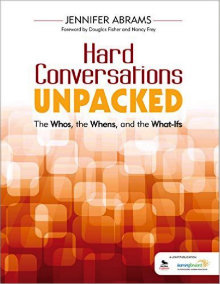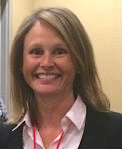How to Be Ready for Hard Conversations
Hard Conversations Unpacked: The Whos, the Whens, and the What-Ifs
By Jennifer Abrams
(Corwin/Learning Forward, 2016 – Learn more)
Recently I completed internship hours alongside my principal in order to become certified as a school administrator. Through my observations and the discussions I had with my principal, I learned quickly that a leader has to have many difficult professional conversations with those within the school organization, including teachers, non-teaching staff members, parents, and even students.
As a school leader, difficult conversations are inevitable. And classroom educators may also find they need to engage in difficult conversations with others, including students, parents, and colleagues.

If we can recall a conversation such as this, whether in our professional or personal lives, we were probably engaged in what Jennifer Abrams, author of Hard Conversations Unpacked: The Whos, the Whens, and the What-Ifs, has termed a “hard conversation.”
I remember such a hard conversation from early in my teaching career. At the school where I worked, the counselor and I met with a parent to discuss a sensitive topic and also make it known that we needed behavior to change.
This was early in my teaching career, but I think I would still be amazed now at how the counselor handled the situation. She knew the right moment to broach the subject, and she did it in a way that maintained the trust we had already built with the parent while also convincing the parent to agree to change.
This school counselor seemed to have an innate ability to engage in hard conversations. This ability does not come naturally to all of us, but Hard Conversations Unpacked can help us be more effective.
The case for hard conversations
I liked that Abrams began the book with a preface that explained the why behind hard conversations. Being an educator comes with the responsibility of having some frank dialogue. Avoiding hard conversations may be an option some choose to take, but Abrams makes the case that they are necessary to our work with and for children. She states,
We need to speak up for the field, advocate for the democratic ideals on which our profession was based, speak for students who don’t have a voice, for the best teaching possible for all students, for the professional cultures we deserve to work in and for the next generation of educators” (p. xii).
This book is for those who want to be better at hard conversations because we don’t believe we have the choice not to have them.
Building a foundation for conversations
The first four chapters provide an understanding of the foundation on which hard conversations that are humane and growth-producing should be built. The following ideas are presented in these chapters:
- Chapter 1: A hard conversation has unique characteristics that make it different from clarifying and coaching conversations.
- Chapter 2: Hard conversations should be respectful interactions that take place at a cognitive level.
- Chapter 3: Maintaining relationships and building trust are necessary for effective hard conversations and being other-focused is a way to achieve this.
- Chapter 4: Understanding the dynamics of relationships and the context within which the conversation takes place is essential.
Abrams discusses these ideas within short chapters. She makes her point and cites many resources. The book includes text boxes with tips for the most productive use of language when having hard conversations. Suggestions such as “Don’t Use Fuzzy Words” and “Watch Your Adjectives” provide practical ways to be effective. Each chapter of the book also ends with a list of cited resources that are also useful for more in-depth reading.
Framing the conversation with a script
My favorite chapter is Chapter Five, “Scripting a Humane, Growth-Producing Conversation.” Abrams discusses six parts of a scripting protocol which she presented in her previous book, Having Hard Conversations. The six parts are:
- Setting the Tone
- Naming the Issue
- Giving Specific Examples
- Clarifying the Impact
- Making a Request for Action
- Indicating a Request for Dialogue
Abrams expands upon each part of the script, describing how the part would be addressed within a hard conversation. Together, the six parts offer a framework for engaging in a conversation that clearly defines expectations and helps others to move forward.
Abrams also provides examples of language that might be used throughout each part of the conversation. These examples helped me envision exactly how a hard conversation would go.
Responding and listening
Chapter Six provides ideas about how to respond during a conversation. Abrams gives sample responses for a variety of “What if they say…?” questions. The last chapter addresses the idea that a conversation is not just about talking, but also about listening. There are many practical strategies about how to listen to feedback and use it to grow. You’ll find a brief article on receiving feedback at Abrams’ website.
Educators should not shy away from hard conversations because they are essential for change. Abrams offers a guide on how to make the process of having a hard conversation a little easier. There is always risk when we have hard conversations, but knowing effective strategies for engaging in this difficult dialogue can help educators build the confidence and skills necessary to create meaningful and positive change.
Lisa Maucione is a literacy specialist at an elementary school in Massachusetts. Before becoming a literacy specialist, she worked as a first grade teacher. She completed a doctoral program through Northeastern University and has certification as a school administrator. Lisa completed a summer institute with her local NWP site, Buzzards Bay Writing Project, and has been a teacher consultant since 2005. You can follow her @DrLMaucione and read her blog Literacy On The Mind.




































